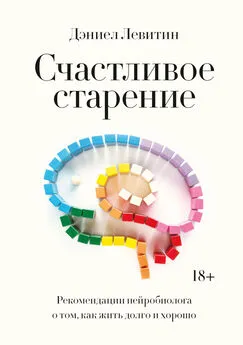Дэниел Левитин - Счастливое старение. Рекомендации нейробиолога о том, как жить долго и хорошо
- Название:Счастливое старение. Рекомендации нейробиолога о том, как жить долго и хорошо
- Автор:
- Жанр:
- Издательство:Манн, Иванов и Фербер
- Год:2021
- Город:Москва
- ISBN:9785001695868
- Рейтинг:
- Избранное:Добавить в избранное
-
Отзывы:
-
Ваша оценка:
Дэниел Левитин - Счастливое старение. Рекомендации нейробиолога о том, как жить долго и хорошо краткое содержание
Ответы на эти и многие другие вопросы вы найдете в книге известного нейробиолога и автора бестселлеров о природе возрастных изменений и о том, как можно прожить долго и что нужно делать сейчас (в любом возрасте), чтобы в 70, 80 и 90 жить полной жизнью.
Книга предназначена для широкого круга читателей.
На русском языке публикуется впервые.
Счастливое старение. Рекомендации нейробиолога о том, как жить долго и хорошо - читать онлайн бесплатно ознакомительный отрывок
Интервал:
Закладка:
322
S. Nolen-Hoeksema, “Responses to Depression and Their Effects on the Duration of the Depressive Episode,” Journal of Abnormal Psychology 100, no. 4 (1991): 569–582; S. Nolen-Hoeksema and J. Morrow, “Effects of Rumination and Distraction on Naturally Occurring Depressed Mood,” Cognition and Emotion 7, no. 6 (1993): 561–570.
323
N. M. Morris and J. R. Udry, “Variations in Pedometer Activity during the Menstrual Cycle,” Obstetrics and Gynecology 35, no. 2 (1970): 199–201; M. Haselton, Hormonal: The Hidden Intelligence of Hormones – How They Drive Desire, Shape Relationships, Influence Our Choices, and Make Us Wiser (Boston: Little, Brown, 2018).
324
S. J. Stanton and O. C. Schultheiss, “Basal and Dynamic Relationships between Implicit Power Motivation and Estradiol in Women,” Hormones and Behavior 52, no. 5 (2007): 571–580; K. Lebron-Milad, B. M. Graham, and M. R. Milad, “Low Estradiol Levels: A Vulnerability Factor for the Development of Posttraumatic Stress Disorder,” Biological Psychiatry 72, no. 1 (2012): 6–7, http://dx.doi.org/10.1016/j.biopsych.2012.04.029.
325
M. Østensen, P. M. Villiger, and F. Förger, “Interaction of Pregnancy and Autoimmune Rheumatic Disease,” Autoimmunity Reviews 11, nos. 6–7 (2012): A437–A446.
326
J. Greenspan et al., “Studying Sex and Gender Differences in Pain and Analgesia: A Consensus Report,” Pain 132 (2007): S26–S45.
327
M. L. Smith et al., “Facial Appearance Is a Cue to Oestrogen Levels in Women,” Proceedings of the Royal Society of London B: Biological Sciences 273, no. 1583 (2006): 135–140; D. S. Fleischman and D. M. Fessler, “Progesterone’s Effects on the Psychology of Disease Avoidance: Support for the Compensatory Behavioral Prophylaxis Hypothesis,” Hormones and Behavior 59, no. 2 (2011): 271–275.
328
Haselton, Hormonal, p. 76.
329
O. C. Schultheiss, A. Dargel, and W. Rohde, “Implicit Motives and Gonadal Steroid Hormones: Effects of Menstrual Cycle Phase, Oral Contraceptive Use, and Relationship Status,” Hormones and Behavior 43, no. 2 (2003): 293–301.
330
E. Timby et al., “Pharmacokinetic and Behavioral Effects of Allopregnanolone in Healthy Women,” Psychopharmacology 186, no. 3 (2006): 414; A. Smith et al., “Cycles of Risk: Associations between Menstrual Cycle and Suicidal Ideation among Women,” Personality and Individual Differences 74 (2015): 35–40.
331
C. Eisenegger, J. Haushofer, and E. Fehr, “The Role of Testosterone in Social Interaction,” Trends in Cognitive Sciences 15, no. 6 (2011): 263–271.
332
S. J. Stanton, S. H. Liening, and O. C. Schultheiss, “Testosterone Is Positively Associated with Risk Taking in the Iowa Gambling Task,” Hormones and Behavior 59, no. 2 (2011): 252–256; см. также: J. M. Coates and J. Herbert, “Endogenous Steroids and Financial Risk Taking on a London Trading Floor,” Proceedings of the National Academy of Sciences 105, no. 16 (2008): 6167–6172.
333
S. M. van Anders, L. D. Hamilton, and N. V. Watson, “Multiple Partners Are Associated with Higher Testosterone in North American Men and Women,” Hormones and Behavior 51, no. 3 (2007): 454–459.
334
S. L. Miller, and J. K. Maner, “Scent of a Woman: Men’s Testosterone Responses to Olfactory Ovulation Cues,” Psychological Science 21, no. 2 (2010): 276–283.
335
O. C. Schultheiss, K. L. Campbell, and D. C. McClelland, “Implicit Power Motivation Moderates Men’s Testosterone Responses to Imagined and Real Dominance Success,” Hormones and Behavior 36, no. 3 (1999): 234–241.
336
M. Ritschard et al., “Enhanced Testosterone Levels Affect Singing Motivation but Not Song Structure and Amplitude in Bengalese Finches,” Physiology and Behavior 102, no. 1 (2011): 30–35.
337
Этот диалог можно найти в «Государстве» Платона. Прим. ред.
338
Eisenegger et al., “The Role of Testosterone in Social Interaction.”
339
Committee on How People Learn II, How People Learn II: Learners, Contexts and Cultures (Washington, DC: National Academies Press, 2018), p. 21, доступно: http://nap.edu/24783.
340
Из личного общения с Полом Саймоном 19 сентября 2013 года.
341
R. Lewis, “No Longer Singing, Linda Ronstadt’s Latest Tour Is a Conversation with the Audience,” Los Angeles Times, October 3, 2018, http://www.latimes.com/entertainment/music/la-et-ms-linda-ronstadt-conversation-20181003-story.html.
342
Из личного общения с Полом Саймоном, Нью-Йорк, 4 марта 2009 года.
343
Committee on How People Learn II, How People Learn II, p. 21.
344
P. L. Ackerman and M. E. Beier, “Determinants of Domain Knowledge and Independent Study Learning in an Adult Sample,” Journal of Educational Psychology 98, no. 2 (2006): 366–381; M. E. Beier and P. L. Ackerman, “Determinants of Health Knowledge: An Investigation of Age, Gender, Abilities, Personality, and Interests,” Journal of Personality and Social Psychology 84, no. 2 (2003): 439–448; M. E. Beier and P. L. Ackerman, “Age, Ability, and the Role of Prior Knowledge on the Acquisition of New Domain Knowledge: Promising Results in a Real-World Learning Environment,” Psychology and Aging 20, no. 2 (2005): 341–355, http://dx.doi.org/10.1037/0882–7974.20.2.341; M. E. Beier, C. K. Young, and A. J. Villado, “Job Knowledge: Its Definition, Development and Measurement,” in The Handbook of Industrial, Work, and Organization Psychology, ed. D. Ones et al. (Los Angeles, CA: Sage, 2018).
345
V. L. Patel, G. J. Groen, and C. H. Frederiksen, “Differences between Medical Students and Doctors in Memory for Clinical Cases,” Medical Education 20, no. 1 (1986): 3–9; см. также: B. L. AndersonMontoya et al., “Running Memory for Clinical Handoffs: A Look at Active and Passive Processing,” Human Factors 59, no. 3 (2017): 393–406.
346
E. L. Deci and R. M. Ryan, Intrinsic Motivation and Self-Determination in Human Behavior (New York: Plenum Press, 1985); E. L. Deci and R. M. Ryan, “The ‘What’ and ‘Why’ of Goal Pursuits: Human Needs and the Self-Determination of Behavior,” Psychological Inquiry 11 (2000): 227–268; R. M. Ryan and E. L. Deci, Self-Determination Theory: Basic Psychological Needs in Motivation, Development, and Wellness (New York: Guilford Publications, 2017).
347
C. S. Dweck, “Even Geniuses Work Hard,” Educational Leadership 68, no. 1 (2010): 16–20.
348
См. Дуэк К. Гибкое сознание. Новый взгляд на психологию развития взрослых и детей.М.: Манн, Иванов и Фербер, 2013. Прим. ред.
349
C. S. Dweck, Mindset: The New Psychology of Success (New York: Penguin Random House, 2008). ( Дуэк К. Гибкое сознание. Новый взгляд на психологию развития взрослых и детей.М.: Манн, Иванов и Фербер, 2013).
350
Некоторые из этих тезисов взяты из: S. Levitin, Heart and Sell (Wayne, NJ: Career Press, 2017), p. 31.
351
C. Dweck, “Carol Dweck Revisits the Growth Mindset,” Education Week 35, no. 5 (2015): 20–24.
352
Committee on How People Learn II, How People Learn II, p. 21; L. L. Carstensen, D. M. Isaacowitz, and S. T. Charles, “Taking Time Seriously: A Theory of Socioemotional Selectivity,” American Psychologist 54, no. 3 (1999): 165–181.
353
D. J. Levitin, “Severed,” The New Yorker, October 10, 2018, https://www.newyorker.com/culture/personal-history/severed.
354
Из личного общения с Тимом Лэддишем 29 октября 2018 года.
355
P. Brickman, D. Coates, and R. Janoff-Bulman, “Lottery Winners and Accident Victims: Is Happiness Relative?” Journal of Personality and Social Psychology 36, no. 8 (1978): 917.
356
См. также: D. A. Schkade and D. Kahneman, “Does Living in California Make People Happy? A Focusing Illusion in Judgments of Life Satisfaction,” Psychological Science 9, no. 5 (1998): 340–346; D. Gilbert, Stumbling on Happiness (Toronto: Vintage Canada, 2009); S. Lyubomirsky, The Myths of Happiness: What Should Make You Happy, but Doesn’t, What Shouldn’t Make You Happy, but Does (New York: Penguin, 2014).
357
Из личного общения с Висенте Фоксом, Леон, Мексика, 18 мая 2018 года.
358
Я начинаю главу с этой цитаты, поскольку она широко известна и звучит актуально для многих из нас. Нам понятно стремление оградить себя от требований и раздражающего характера других людей. Однако это ошибочная интерпретация слов Сартра. Он не имел в виду, что человек становится счастливее в изоляции. На самом деле он хотел сказать, что мы не можем избежать суждений других людей, их пристального внимания и того стыда, который ощущаем, когда они видят наши недостатки. Полная цитата из пьесы No Exit («За закрытыми дверями») звучит так: «Эти пожирающие взгляды… А! Вас только двое? Я думал: гораздо больше. Так вот он какой, ад! Никогда бы не подумал… Помните: сера, решетки, жаровня… Чепуха все это! На кой черт жаровня? Ад – это другие» (перевод Л. Каменской). P. Caws, “To Hell and Back: Sartre on (and in) Analysis with Freud,” Sartre Studies International 11, no. 1 (2005): 166–176. Сам Сартр сказал об этом следующее: «Фразу “Ад – это другие” всегда понимали неправильно. Принято считать, что я имел в виду, будто наши отношения с другими людьми всегда отравлены, будто это неизбежно адские отношения. Однако я имел в виду нечто совершенно иное. Я хотел сказать, что, если отношения с кем-то запутанны, испорчены, этот человек действительно может быть только адом. Почему? Потому что… когда мы размышляем о себе, когда пытаемся познать себя… мы используем то знание себя, которое уже есть у других людей. Мы оцениваем себя с помощью тех инструментов, которые есть у других людей и которые они нам предоставили, для того чтобы мы оценивали себя. В то, что я говорю о себе, всегда вмешивается чье-то суждение. В то, что я ощущаю внутри, всегда вмешивается чье-то суждение. …Однако это совсем не значит, что нельзя поддерживать взаимоотношения с другими людьми. Это просто подчеркивает исключительное значение людей для каждого из нас».
Читать дальшеИнтервал:
Закладка:








![Дэниел Левитин - Путеводитель по лжи [Критическое мышление в эпоху постправды]](/books/1101191/deniel-levitin-putevoditel-po-lzhi-kriticheskoe-my.webp)

